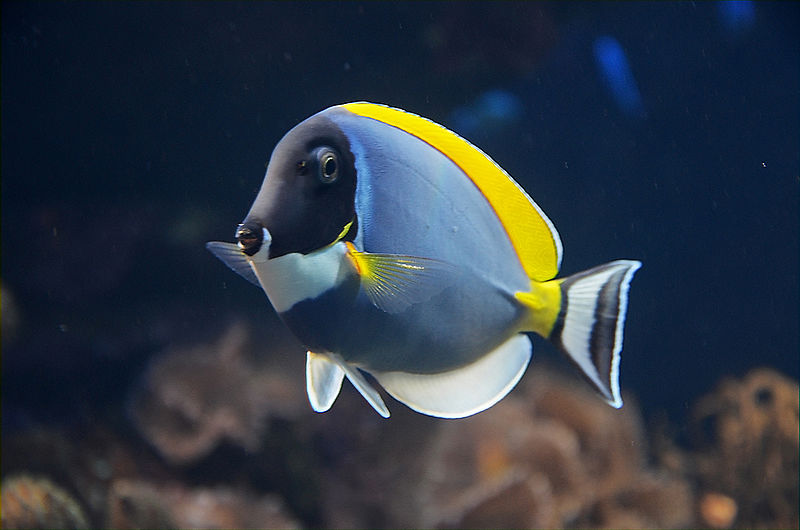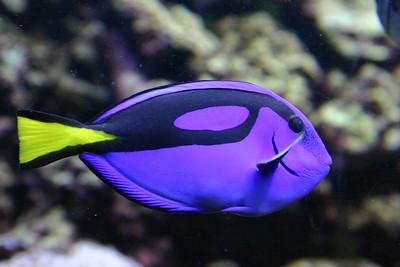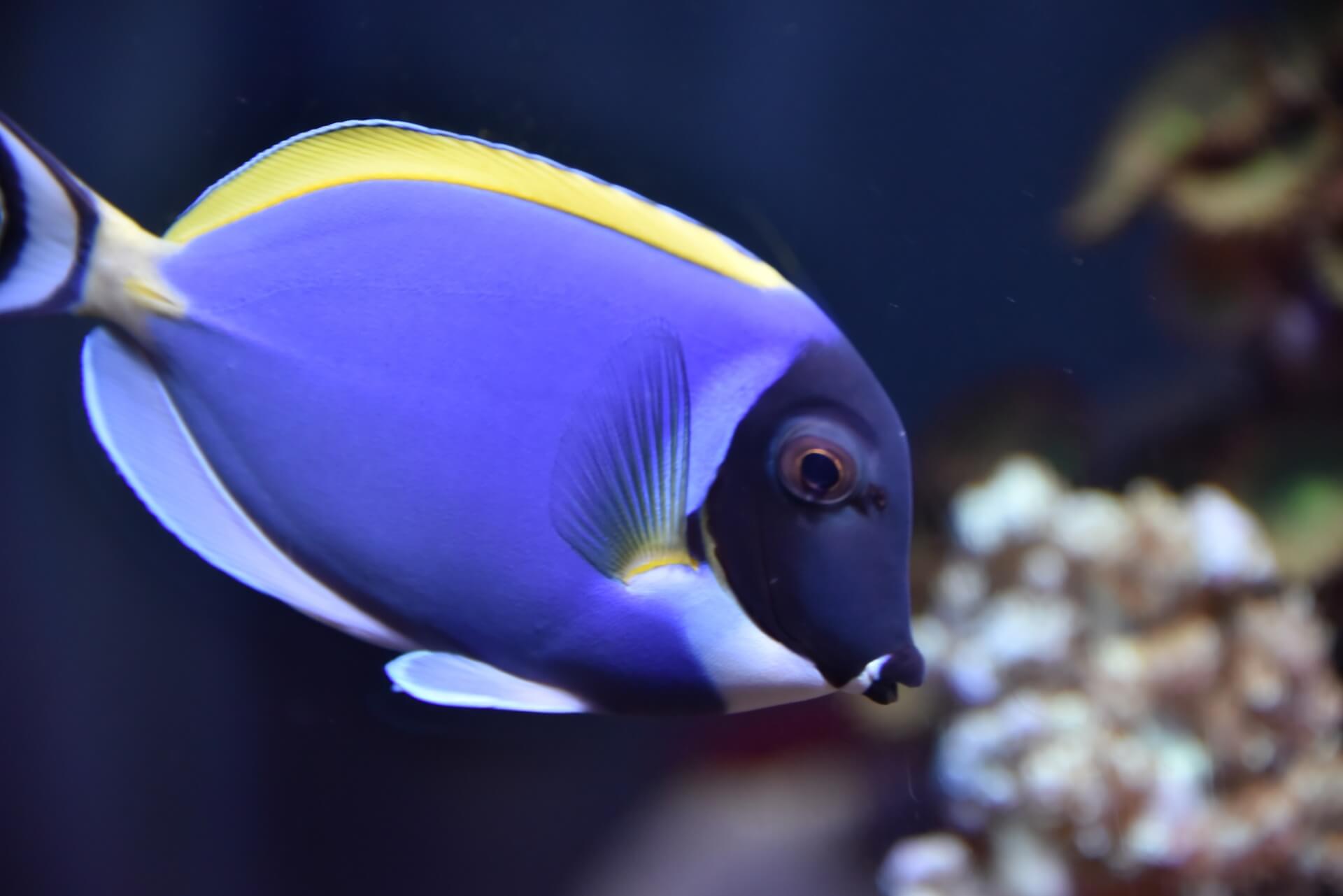Powder Blue Tang: Care, Acclimation, Reef Compatibility & More
Posted by on 3/30/2023
We use affiliate links and may receive a small commission on purchases.
Known for being a challenging fish to keep, the Powder Blue Tang (abbreviated as PBT) is an attractive and large-sized surgeonfish that will easily be the center of attention in a marine aquarium.
If you own a large enough tank, the Powder Blue Tang can serve as a fascinating centerpiece fish. Its striking markings and aggressive personality have been captivating the minds of hobbyists since its discovery, but hobbyists interested in purchasing the species should have a strong understanding of the work required to own such a unique fish. In this care guide, we're going to outline everything you'll need to decide whether or not the Powder Blue Tang is the right fish for you.
Table of Contents
December's Giveaways on Light Fish
Species Summary
The Powder Blue Tang (scientific name: Acanthurus leucosternon) hails from the reefs of the Indo-Pacific. First scientifically classified by English zoologist Edward Bennett the species faces little predation in the wild and has earned a Least Concern designation by the IUCN .
Similar to other species of surgeonfish, the Powder Blue Tang has a sharp spine that sits behind the fish's dorsal fin. The species is capable of performing a slashing maneuver, skewering, and warding off any potential predators with its sharp spine.

Appearance
The Powder Blue Tang is without a doubt one of the more attractive species of surgeonfish. A predominantly light-blue body is accented by translucent yellow pectoral fins. An opaque yellow dorsal fin sits on top of the body and is outlined in a dark blue and teal coloration. The fish's tail fin displays varying shades of gray, navy, and light blues. The fish's caudal peduncle, the area that sits behind the fish's dorsal fin which contains its signature spine, is bright yellow in coloration.
Interestingly, the fish's pelvic and anal fins feature an opaque white coloration that transitions to a light-colored blue. The fish's face displays a beautiful dark-blue coloration, outlined by a white chin, which extends to the fish's navy-colored lips.
Due to the Powder Blue's unique appearance, it's easy to understand why this surgeonfish is one of the most sought-after in the hobby.

Male vs Female
Male and female powder blue tangs are virtually indistinguishable, the only difference is their size. Males will typically be a few inches smaller than females, which is typical for all species under the Acanthurus genus.
Powder Blue Tang vs Blue Hippo Tang
Powder Blue Tangs may often be confused with the Blue Hippo Tang (scientific name: Paracanthurus hepatus), the fish made famous by the popular Pixar movie, Finding Nemo.
Hobbyists should look towards the body of the fish to notice the obvious visual differences. Blue Hippo Tangs will have a distinct black pattern on the upper portion of the fish's body. This pattern does not exist on the powder blue.
Blue Hippo Tangs also tend to be much less aggressive than Powder Blues, but temperament does vary between individual fish.

Size
Powder Blue Tangs are relatively large fish, and adults will typically reach about 8 inches in length.
As with all fish, providing a well-balanced diet and a pristine living environment will promote healthy growth rates.
Powder Blue Tang Care
Hobbyists considering a Powder Blue Tang should be aware that they are not the easiest fish to care for. They require plenty of swimming space and are highly vulnerable to diseases such as Marine Ich.
Let's review some of their care requirements.
Lifespan
When provided a pristine environment and well-balanced diet, the Powder Blue Tang can live for up to 40 years.
Yup, you read that correctly, you could raise an entire family within a Powder Blue Tang's lifespan. These are long-lived fish, and while they tend to not live as long in captivity, you should be prepared for having these fish around for a long while.
Tank Size
You'll need an aquarium that's at least 125 gallons in size if you plan on adding a Powder Blue Tang.
Powder Blue Tangs are active fish and fast swimmers - often seen darting from one side of a tank to the other. Providing them with a large enough tank will give them plenty of space to swim, and will curtail aggressive behavior.
Acclimation
Powder blue tangs should be quarantined in an established quarantine tank for at least 4 weeks before they're released into your display tank. Due to their thin slime coats, they're more vulnerable to diseases compared to other marine fish.
Before moving a Powder Blue Tang into your quarantine tank, you'll want to match the salinity levels and temperature that the fish is currently being exposed to with that of your quarantine tank.
If the salinity levels differ by more than .001, you'll need to perform drip acclimation.
To perform drip acclimation, you'll need the following:
- Small Bucket (you'll want a bucket small enough that your fish will be able to swim with only their shipped water)
- Seachem Prime
- Aquarium Heater
- Airline Tubing or Drip Acclimation Kit
Using the airline tubing or drip acclimation kit, slowly drip water from your quarantine tank into the bucket housing your Powder Blue Tang. Add a small amount of Seachem Prime to detoxify ammonia. After about 30 minutes, re-test your salinity levels.
Once the salinity levels are within .001, you can add the fish directly into your quarantine tank. Do not add the water your Powder Blue Tang was shipped with into your quarantine tank.
If salinity levels are already within .001, acclimation is a bit easier, and you can simply float the bag in your quarantine tank for 30 minutes to allow temperatures to align. After 30 minutes have passed, you can release the fish directly into the tank. Once again, be sure to not release the shipped water into your quarantine tank, transfer only the fish.

It's not uncommon for newly acquired Powder Blue Tangs to already have marine ich, and if they do, they'll require copper treatment. Chelated copper products, such as Copper Power or CopperSafe can be used for treatment in a quarantine tank, but avoid ionic copper products such as Cupramine as these can have adverse effects on livestock.
Assuming you've treated any diseases, or your fish has shown no signs of illness over a 4-week quarantine period, you can transfer the Powder Blue Tang into your display tank. Double-check that quarantine and display tank temperatures and salinity levels match. If they do, you can transfer the fish directly into the display tank, or an acclimation box .
Water Conditions
Unlike other species of surgeonfish, Powder Blue Tangs require higher levels of pH that must be consistently maintained in a marine environment.
The following parameters should remain consistent for the duration of your Powder Blue Tang's life:
Specific Gravity: 1.020-1.025
Temperature Range: 80°F-84°F
KH: 8-12 dKH
pH: 8.2-8.4
Ammonia: 0ppm
Nitrite: < .2ppm
Nitrate: < 10ppm
Regularly testing your aquarium water with test kits from businesses like Hanna is strongly recommended for sensitive species like the Powder Blue Tang.
Tank Setup
Re-creating a Powder Blue Tang's natural environment in an at-home aquarium is no easy feat, but with the proper equipment, it can be accomplished.
Powder Blue Tangs prefer high levels of flow, so you'll want to provide one or two adjustable powerheads .
We strongly recommend an aquarium with a sump, and an optional refugium. Combined, these systems will add more water volume to your aquarium, reducing the chances that you'll experience a sudden change in water chemistry.
Providing plenty of live rock is recommended, as it will create plenty of surface area for algae to grow. Powder Blue Tangs will graze on these algae, which is an essential part of their overall diet. When positioning live rock, make sure to allow for plenty of open space in the tank. Powder Blue Tangs are active swimmers, and will not do well in an overcrowded aquarium.
Common Diseases
Powder Blue Tangs do not have the thicker slime coats seen in species such as the Christmas Wrasse, and as such are more vulnerable to potential diseases.
Some of the most commonly found marine diseases are Marine Velvet and Ich, and we discuss their symptoms and treatment in more detail in another one of our blog posts Marine Velvet vs Ich: Similarities, Differences, Causes & Treatment.
It's always best practice to quarantine a Powder Blue Tang, or any new tank additions for that matter, in an established quarantine tank to prevent the spread of these diseases.
Food & Diet
In the Indo-Pacific, the Powder Blue Tangs diet consists almost entirely of algae, and hobbyists will want to re-create this herbivorous diet in their aquariums.
Powder Blue Tangs should be fed algae sheets daily with a vitamin supplement such as Selcon .
Hobbyists can either provide a consistent supply of algae sheets, swapping the older sheet with a new sheet every 24 hours, or directly feed frozen mysis shrimp, nori, spirulina, and brine shrimp 3 times per day.
Powder Blue Tangs are big eaters, and will constantly graze on available algae in the tank. A single Powder Blue Tang can easily consume an algae sheet within 2 hours. Always monitor your Powder Blue Tang to ensure that they're getting ample amounts of food.
Behavior and Temperament
Powder Blue Tangs are known as aggressive fish, but these fish only show signs of aggression towards other tangs and surgeonfish. Hobbyists looking to acquire a Powder Blue Tang will see a peaceful temperament as long as it's the only tang kept in their aquarium.
Hobbyists that are considering housing multiple tangs, can mitigate their aggressive behavior by providing a massive aquarium, one that's at least 200 gallons in size.
Introducing multiple tangs at once may also reduce aggressive behavior. Tangs that are added after a Powder Blue Tang has established territory will most likely see aggressive behavior. Keep in mind that temperament does vary between fish, while some hobbyists may witness peaceful behavior between multiple tangs, others will see signs of aggression.
Besides their temperament, powder blue tangs are fast, active swimmers, and will constantly patrol the tank looking for new food sources and algae to graze upon.
Reef Compatibility
Powder Blue Tangs are reef-safe fish and will do well with all sorts of corals and anemones. Some potential corals include blastos, torches, and chalices.
For those interested in keeping anemones, they'll be ignored by the Powder Blue Tang, making anemone color morphs such as the Black Widow an attractive option for a tank housing both anemonefish and a Powder Blue Tang.
Tank Mates
The Powder Blue Tang can co-exist with many peaceful aquarium species. As herbivores, few species will present an issue when kept with a Powder Blue Tang.
Some potential tank mate options include:
Avoid aggressive species, such as the Blue Spotted Puffer, Maroon Clownfish and Tessalata Eel.
While the Powder Blue Tang may be able to coexist with other tangs, such as the Blonde Naso, Kole Yellow Eye, and Gem Tang, it's a risky decision, and for that, we recommend avoiding other tangs altogether.
Breeding
Unfortunately, there have been no instances where the Powder Blue Tang has been successfully bred in captivity.
However, there may be hope in the future. In 2023, we've seen our first captive-bred Emperor angelfish , and Biota already offers captive-bred Blue Tangs .
Hopefully, we'll see Powder Blue Tangs receive the captive-bred designation in the future.
Where to Purchase
Powder Blue Tangs have been sold by vendors on our marketplace, and can occasionally be found for sale by some of the larger online vendors, like LiveAquaria.
When possible, it's always worth checking their availability at any nearby local fish stores. Before purchasing, make sure you have a strong understanding of their current tank conditions and the estimated age of the fish. After purchasing, always re-test their water so that you can properly acclimate them.
In Conclusion
After learning all about the Powder Blue Tang, do you plan on adding this fish to your display tank? These fish certainly have a lot to offer, and their active lifestyle makes them quite a spectacle in an at-home aquarium.
Let us know if you've had experience with this fish in the comments below, and be sure to visit our marketplace and community forum where you can buy, sell, and discuss fishkeeping with other like-minded aquarium hobbyists.
December's Giveaways on Light Fish


